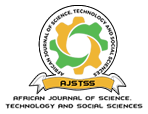Tracking the flow of excreta across the sanitation service chain in Nkubu town
DOI:
https://doi.org/10.58506/ajstss.v1i1.88Keywords:
Safely managed, sanitation systems, service delivery, feacal sludge, shit flow diagram, treatmentAbstract
Inadequate access to improved sanitation and water remains a huge factor contributing to increased mortality and morbidity rates, especially among children. Despite the growth in economy and recognition of sanitation as a basic right, investment in sanitation infrastructure has not yet been achieved, particularly in low- and middle-income area. As such, nearly 827 000 people die yearly due to inadequate sanitation, water and hygiene. To track the flow of excreta in Urban areas, the existing sanitation systems were assessed, the proportion of community with access to safely managed feacal sludge was examined, the challenges facing service delivery was assessed and finally, a Shit Flow Diagram for Nkubu town was developed. A descriptive cross-sectional survey was employed. The research instruments involved were use of key informants’ interviews, observation for primary data. The secondary data was gotten from existing data. The Susana platform and the shit flow diagram tools were used for data analysis and generating SFD for Nkubu town. The data collected has been presented using a shit flow diagram, tables, graphs and charts. The results indicate that only 28% of the excreta is safely managed. The pit latrines were the most used containment method with 45% and 3% of the population practicing open defecation. Only 40% of the feacal sludge taken to the treatment was properly treated and disposed. The challenges experienced in the management of fecal sludge were high water table in the area and high license and service fee charged. The findings imply that the unsafely excreta management practices in Nkubu town pose a risk to the health of residents in and around the town and the quality of water sources. This study points to the possible areas of interventions such as proper planning of the town and also creating an enabling environment for feacal sludge management.


